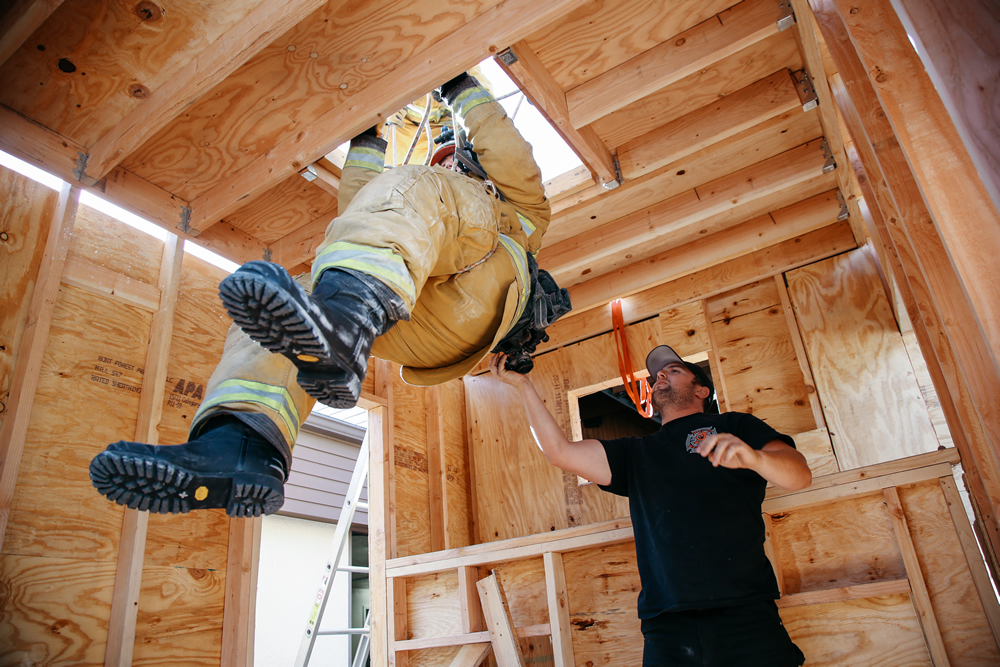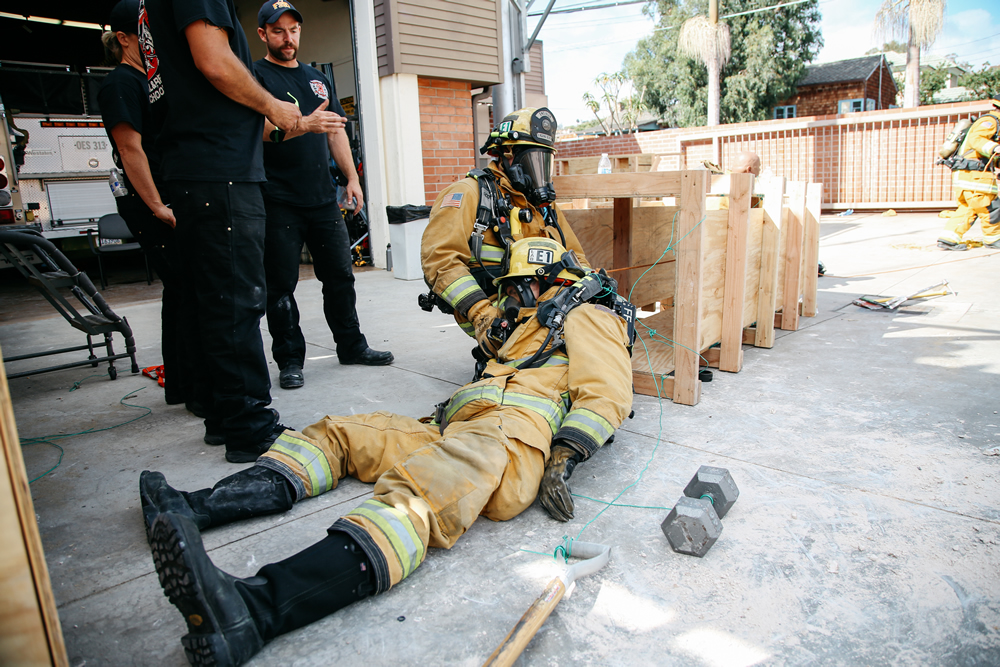
Like each of the 40 firefighters in the Laguna Beach Fire Department, training division commander Api Weinert was pushed nearly to the limit of his physical endurance recently.
Already taxed by performing calisthenics in protective gear to simulate the physical exertion of fire fighting, Weinert was expected to crawl through an eight-foot tunnel, 17 inches square, strung with entangling wires in a survival drill. With his mask blacked out to simulate vision-obscuring smoke and breathing from an air bottle, his task was to save himself from the entrapment by cutting his way out amid the din of alarms and sirens.

Weinert, who is right-handed, stocks the right pocket of his turn-out jacket with wooden wedges to prop open doors, webbing to tie back obstructions, rubber gloves and wire-cutting pliers. “I could not pull out my pliers,” Weinert said, pointing out that in his exhausted state and in such tight quarters, his eye-hand coordination degraded.
The eye-opening experience yielded at least one potentially life-saving lesson that Weinert put into practice immediately. His pliers will remain in the uncluttered left pocket of his coat.

As a result of the specialized department-wide survival training, “everyone’s going to come away with new information,” promised Michael Snodgrass, the lead instructor, a Gresham, Ore., firefighter lieutenant who volunteers to train his colleagues to survive the unexpected.
In the immediate aftermath of Sept. 11, 2001, when 340 firefighters died in New York alone, more training nationwide focused on firefighter survival, Snodgrass said. He is trying to sustain ebbing momentum by organizing survival training through the Randy Carpenter Memorial Foundation, established in Coos Bay, Ore., by brothers of a firefighter who died on duty.
The intensive training aims to replicate actual scenarios where firefighters have died in cities such as Denver and Boston. In 2015, 68 on-duty firefighters died; sudden cardiac deaths accounted for half, according to the National Fire Protection Association, of Quincy, Mass., which develops fire codes and standards.
Laguna is the foundation’s first training across an entire department and its seventh session since April, Snodgrass said. Nine different instructors, all working firefighters, volunteered to rotate in and participate in the three-day sessions in each of the previous three weeks to conduct the training, he said. After first starting at the Agate Street station, training shifted to the ACT V parking lot. Laguna covered the $15,000 tab for travel and lodging, Weinert said.
Previously, such training for the whole department would have taken four months, Weinert said. One of Laguna’s four station crews would spend one eight-hour period at a training center in Newport Beach or the former Tustin air base. By bringing the training to Laguna, everyone could rotate through without over-taxing neighboring departments to cover the entire city, he said.
Firefighters train incessantly, but their missions are varied and the majority of service calls are for medical aid. Next month, for example, Weinert said Laguna paramedic engineers will go to Hoag hospital for advanced cardiac training. Another engine company will practice live fire training in Huntington Beach. And each engine company will get a turn at the wheel of the department’s new wildland engine.
The foundation’s survival training uses props built by the trainers to simulate actual death-traps. “It’s intense enough it builds experience,” Snodgrass said.
Instructors go beyond standardized self-rescue training, such as how to bail out of a window (a rolling head dive). Their scenarios involved escaping from entanglements, a common predicament caused by dropping electrical conduits or mini-blind pulls; how to escape from a collapsed building; how to perform CPR when a firefighter’s turnout-gear is super-heated; and how to rescue a 200 pound firefighter from a basement after a floor collapse (lift, not pull).
“With our cliffhanger homes, the technique has a lot of application in our town,” Weinert pointed out.
As a measure of the training’s intensity, firefighters were consuming 100 bottles a day of compressed air, 10 times what was expected, Weinert said. In a typical fire that is knocked down in 30 minutes, firefighters consume two bottles, each adequate for 30 minutes under relaxed conditions. During training, bottles emitted low-volume chirping warnings on average every eight minutes, Weinert said.
To be sure, the training will give firefighters more tools at their command to save a firefighter or a citizen, he said. But it also accomplished something else, too, said Weinert, who kept skepticism to himself over whether everyone on the staff could complete the strenuous scenarios.
“It’s like walking on hot coals,” he said. Once one person makes the passage, others gain the confidence to proceed, he said.
Snodgrass sees it differently. He’s motivated by the mantra of Randy Carpenter, namesake of the survival-school foundation. “Preparation is the difference between a good firefighter and a great firefighter,” said Snodgrass, who says he’s still waiting for the email that credits the training with saving a life.
He’s figures one will show up soon enough.





[…] safety, notes the city manager’s weekly update. Jennie coordinated an intense three-day training class where personnel were put through survival drills. He was also the coordinator for the […]